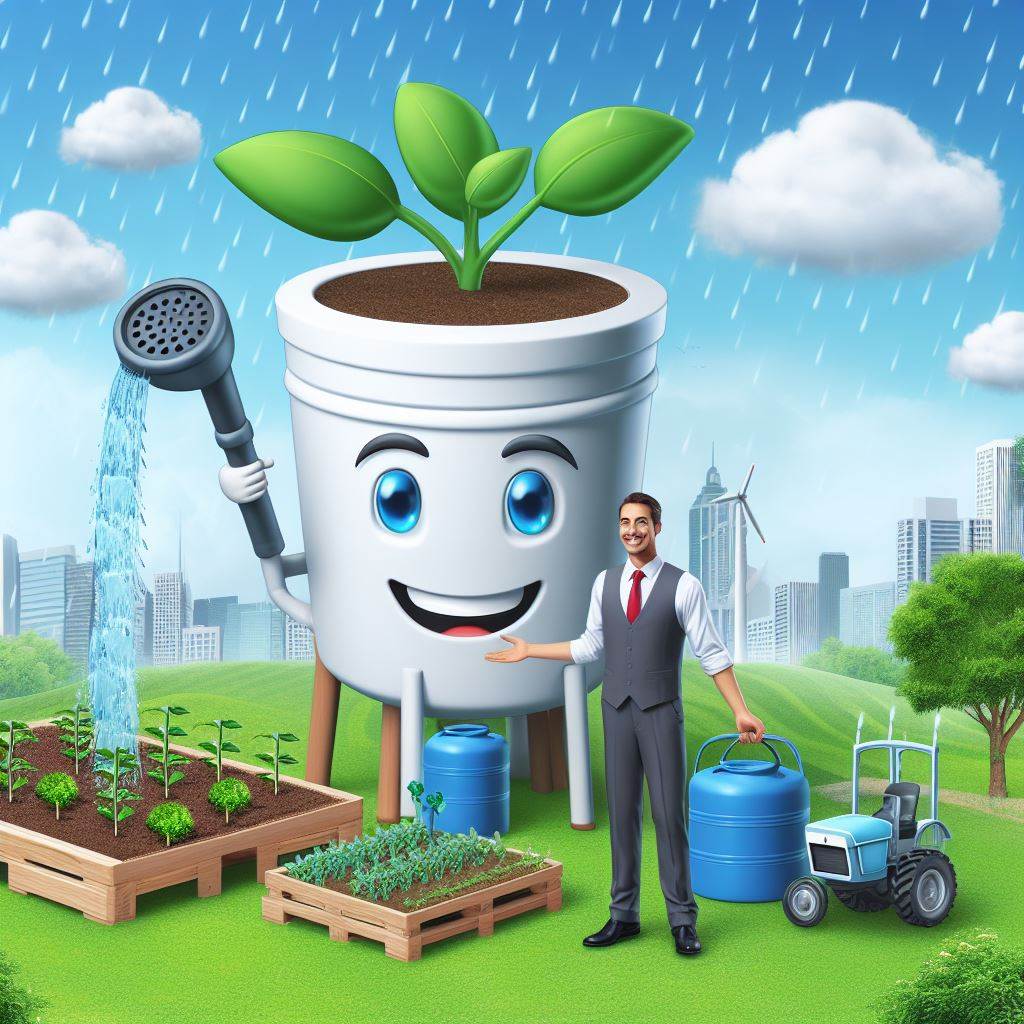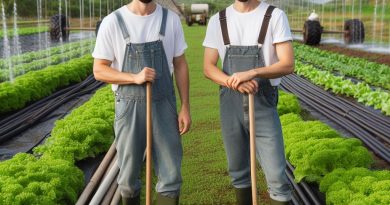Sustainable Crops: Less Water, More Yield Strategies
Last Updated on January 21, 2024
Introduction
Let’s explore sustainable crops: Less water, more yield strategies.
Sustainable agriculture is crucial for the future as it focuses on conserving resources while maximizing crop productivity.
Sustainable crops play a significant role in achieving this goal. This blog section will specifically highlight strategies that aim to both conserve water and increase crop yield.
Sustainable agriculture is essential to ensure long-term food security and protect the environment.
Sustainable crops are cultivated using methods that minimize negative impacts on the ecosystem.
Water conservation is a key aspect of sustainable agriculture, as it helps combat water scarcity and reduce environmental degradation.
Strategies such as precision irrigation and drip irrigation systems can significantly reduce water usage.
Implementing these practices ensures that water is used efficiently, benefiting both crop growth and the environment.
To enhance crop yield, sustainable practices like crop rotation, cover cropping, and soil management techniques are employed.
These methods improve soil fertility, reduce pests and diseases, and enhance nutrient availability.
Additionally, the use of organic fertilizers and biocontrol agents promotes sustainable crop production.
Sustainable agriculture and the use of sustainable crops are essential components of a resilient and efficient food production system.
By prioritizing water conservation while maximizing crop yield, we can ensure a secure and environmentally friendly future for agriculture.
Implementing sustainable practices not only benefits farmers but also helps preserve natural resources for future generations.
Let us all work towards a more sustainable and productive agriculture industry.
Water-efficient irrigation techniques
Water scarcity and the need for sustainable agriculture have led to the development of water-efficient irrigation techniques.
These methods aim to maximize crop yield while minimizing water consumption, making them crucial in today’s agricultural practices.
Drip irrigation system
One of the most effective water-efficient irrigation techniques is the drip irrigation system.
This system works by delivering water directly to the roots of plants, reducing water loss due to evaporation.
Unlike traditional overhead sprinklers, which often waste water by spraying it over large areas, drip irrigation provides a precise and controlled water supply.
Explanation of how it works
The drip irrigation system operates through a network of tubes and emitters that release a steady flow of water to the plant’s root zone.
This ensures that plants receive consistent moisture, promoting healthier growth and reducing water stress.
By eliminating water wastage and minimizing weed growth, drip irrigation can significantly reduce water usage by up to 50% compared to conventional methods.
Benefits of using drip irrigation
The benefits of using drip irrigation go beyond water conservation.
The controlled water supply prevents excessive moisture on leaves, reducing the risk of fungal diseases.
Additionally, because the water is delivered directly to the root zone, nutrients can be efficiently absorbed, resulting in improved plant health and higher crop yields.
Examples of successful implementation
Many successful implementations of drip irrigation can be observed in various agricultural sectors.
Vineyards, for example, have adopted this technique to optimize grape production and enhance wine quality.
Vegetable farms also benefit from drip irrigation, as it allows farmers to precisely control water application, leading to better crop productivity and quality.
Similarly, fruit orchards have witnessed significant improvements in fruit size, flavor, and shelf life through the adoption of drip irrigation systems.
Precision irrigation
Use of sensors and data analysis
Another water-efficient irrigation technique gaining popularity is precision irrigation.
This method involves the use of sensors and data analysis to determine the precise irrigation needs of crops.
By monitoring soil moisture, weather conditions, and crop characteristics, this technology enables farmers to tailor their irrigation practices to specific plant requirements.
Advantages of precision irrigation
Precision irrigation offers several advantages over traditional irrigation methods.
By providing the right amount of water at the right time, it optimizes water usage, reducing waste and conserving valuable resources.
Additionally, precision irrigation maximizes nutrient uptake by ensuring that water and fertilizers are applied precisely where they are needed, enhancing crop quality and yield.
Case studies showcasing successful results
Successful results of precision irrigation can be seen through various case studies.
In corn production, for instance, precise irrigation scheduling based on soil moisture data led to increased yields and improved water-use efficiency.
Cotton farms using precision irrigation techniques have reported higher fiber quality and reduced water runoff, resulting in environmental benefits.
Citrus fruit growers have also implemented precision irrigation to enhance fruit size, sweetness, and overall market value.
Water-efficient irrigation techniques like drip irrigation and precision irrigation play a vital role in sustainable farming practices.
These methods not only conserve water but also contribute to higher crop yields, improved quality, and environmental stewardship.
As water scarcity continues to be a global concern, the adoption of these strategies becomes increasingly important for a more sustainable future in agriculture.
Read: Eco-Friendly Farming: Water-Saving Techniques Revealed
Crop selection and rotation
Choosing plants suitable for the local climate
- Understand specific needs: To thrive in varying climates, crops must match local environmental conditions precisely.
- Examples of drought-tolerant crops: Opt for resilient varieties like millet, sorghum, and drought-resistant beans.
Implementing Crop Rotation Practices
- Benefits explained: Crop rotation enhances soil fertility, minimizes pests, and reduces the risk of diseases.
- Different crop rotation patterns: Rotate between legumes, grains, and cover crops to maintain soil health and nutrient balance.
- Success stories from farmers: Hear tales of increased yields, improved soil structure, and reduced dependency on external inputs.
Active choices in crop selection and rotation can revolutionize agriculture, ensuring sustainability, resilience, and higher yields.
By embracing drought-tolerant varieties suited to the local climate, farmers pave the way for success.
Implementing strategic crop rotation practices becomes a cornerstone, fostering soil health and biodiversity.
These practices not only enhance productivity but also contribute to a resilient and sustainable agricultural ecosystem.
Join the movement towards sustainable crops – less water, more yield!
Read: Rainwater Harvesting: A Farmer’s Guide to Sustainability
Soil conservation techniques
Soil conservation is vital for sustainable crop production. Implementing effective techniques can enhance soil health, water retention, and overall crop yield.
In this section, we will delve into two significant soil conservation methods: cover cropping and conservation tillage.
Cover cropping
Explanation of cover cropping
Cover cropping involves planting specific crops to protect and improve the soil when the main crop is not in the field.
This technique offers numerous benefits to soil health and water retention.
Cover crops help prevent soil erosion by covering the ground and shielding it from heavy rain or wind.
They act as a natural barrier against the elements, reducing the risk of soil particles being washed away.
This conservation strategy also enhances soil structure, promoting a healthy environment for beneficial soil organisms.
Benefits to soil health and water retention
Additionally, cover crops help retain water in the soil. Their root systems penetrate deep into the ground, creating channels for better water infiltration.
This reduces surface runoff and enhances the soil’s ability to absorb and store moisture, making it more resilient during dry periods.
Improved water retention contributes to the sustainability of crops and reduces the need for excessive irrigation.
Experiences of farmers using cover crops
Farmers who have implemented cover cropping techniques report positive experiences.
They observe improved soil fertility and reduced weed pressure.
Cover crops suppress weed growth by shading the soil, preventing weed seeds from germinating.
This reduces the need for herbicides, which is both environmentally friendly and cost-effective.
Moreover, the increased organic matter from cover crops enriches the soil, providing essential nutrients for subsequent crops.
Conservation tillage
Explanation of conservation tillage methods
Conservation tillage involves minimizing soil disturbance during planting and cultivating crops.
It aims to preserve soil structure and moisture content while reducing erosion risks.
Various conservation tillage methods exist, such as no-till, strip-till, and reduced tillage.
No-till farming completely avoids mechanical soil disturbance, leaving the previous crop’s residue intact.
Strip-till farming disturbs only a narrow strip where the seeds will be planted while leaving the rest undisturbed.
Reduced tillage involves minimizing the number of tillage passes and using specific implements to disturb the soil minimally.
Positive impacts on soil moisture conservation
Conservation tillage has numerous positive impacts on soil moisture conservation.
By reducing soil disturbance, it prevents water evaporation from the soil surface.
Crop residues left on the field act as a protective layer, reducing soil moisture loss due to evaporation.
The soil remains cooler, and moisture stays locked in for the benefit of the crops.
Real-world examples of successful conservation tillage
Real-world examples showcase the success of conservation tillage. Many farmers worldwide have adopted this practice and witnessed noticeable improvements.
Increased soil moisture levels have been observed, resulting in reduced irrigation needs.
Additionally, conservation tillage helps maintain soil structure, preventing compaction and promoting the movement of water through the soil profile.
In essence, soil conservation techniques play a crucial role in sustainable crop production.
Cover cropping and conservation tillage are effective strategies to enhance soil health, retain water, and increase crop yields.
By implementing these practices, farmers can contribute to a more sustainable agricultural system that conserves water while maximizing productivity.
Read: Smart Drip Irrigation: Boosting Farm Water Efficiency

Modern technology and practices
Use of precision agriculture technology
Introduction to remote sensing and imaging tools
Remote sensing and imaging tools enable farmers to gather data about their crops without physically inspecting them.
How technology can help optimize water usage
Precision agriculture technology allows farmers to monitor soil moisture levels and deliver water precisely, minimizing wastage.
Case studies of farms utilizing modern technology
Several farms have integrated precision agriculture technology into their operations, resulting in increased crop yield and water efficiency.
Adoption of sustainable farming practices
Organic farming methods and their water-saving benefits
Organic farming practices, such as composting and crop rotation, enhance soil health and reduce water requirements.
Importance of integrated pest management
Integrated pest management combines various strategies to control pests while minimizing water use and environmental impact.
Examples of farms implementing these practices
Several farms are successfully implementing organic farming methods and integrated pest management to achieve sustainable crop production.
In today’s rapidly changing world, sustainable agriculture practices have become a necessity.
Population growth, climate change, and water scarcity pose significant challenges for farmers.
To address these challenges, modern technology and practices play a crucial role.
Use of precision agriculture technology
The use of precision agriculture technology has revolutionized the agricultural industry.
Farmers now have access to remote sensing and imaging tools that provide valuable insights into crop health and environmental conditions.
By using drones and satellites, farmers can identify areas that require water, fertilizer, or pest control, thereby optimizing resource allocation.
This technology helps minimize water usage by ensuring that crops receive the required amount of water without wastage.
Adoption of sustainable farming practices
Adoption of sustainable farming practices is also essential for maximizing yields while conserving water resources.
Organic farming methods prioritize soil health and biodiversity.
Through techniques like composting, cover cropping, and crop rotation, organic farmers enhance water-holding capacity, reduce soil erosion, and increase resilience to drought.
These practices not only save water but also promote long-term sustainability.
Moreover, integrated pest management (IPM) minimizes the reliance on chemical pesticides and utilizes a combination of techniques to control pests.
By utilizing biological control agents, crop rotation, and trap crops, farmers can effectively manage pests while minimizing water usage and environmental impact.
IPM reduces the need for regular pesticide application, which saves water and contributes to overall sustainability.
Real-world examples demonstrate the success of farms that have embraced modern technology and sustainable practices.
Many organic farms have achieved high yields while reducing water consumption.
By implementing organic farming methods, farms like Green Pastures have reported 30% less water usage compared to conventional farms.
Similarly, farms using precision agriculture technology, such as CropSense Farm, have seen a significant increase in crop yield, water efficiency, and overall profitability.
In a nutshell, modern technology and sustainable farming practices offer viable solutions to the challenges faced by the agricultural industry.
Precision agriculture technology allows farmers to optimize water usage through remote sensing and imaging tools.
Embracing organic farming methods and integrated pest management reduces water requirements and promotes long-term sustainability.
By adopting these strategies, farmers can ensure the production of sustainable crops while conserving water resources for future generations.
Read: Organic vs Conventional: A Deep Dive Analysis
Government policies and incentives
Overview of current government policies promoting sustainable agriculture
The government recognizes the importance of sustainable agriculture in ensuring food security and preserving natural resources.
Various policies have been implemented to encourage farmers to adopt sustainable practices.
One of the key policies is the promotion of organic farming methods.
The government provides support and technical assistance to farmers who are transitioning to or practicing organic farming.
This includes providing information on organic certification, subsidies for organic inputs, and training programs on organic farming techniques.
Another policy is the implementation of water management strategies.
The government encourages farmers to adopt water-efficient irrigation techniques such as drip irrigation and precision farming.
Incentives are given to farmers who invest in technologies that reduce water usage while maintaining crop yields.
Additionally, the government promotes agroforestry practices.
Agroforestry combines agriculture and forestry techniques, allowing farmers to grow crops alongside trees.
This approach not only helps in conserving water but also improves soil health and biodiversity.
Incentives and grants for water-efficient farming
To further support water-efficient farming practices, the government provides various incentives and grants to farmers.
These incentives aim to reduce farmers’ financial burden and encourage them to adopt irrigation systems that minimize water waste.
One example of incentives is the provision of subsidies for purchasing water-efficient irrigation equipment.
Farmers can apply for grants that cover a portion of the cost of installing drip irrigation systems or other water-saving technologies.
Moreover, the government offers financial assistance in the form of low-interest loans to farmers who want to invest in water-efficient farming practices.
This enables farmers to fund the upfront costs of implementing water-saving measures without facing significant financial hurdles.
Success stories of farmers benefitting from government programs
Government programs have shown significant success in supporting farmers and promoting sustainable agriculture.
Many farmers who have participated in these programs have experienced positive outcomes.
For instance, a farmer named John, who received government assistance to transition to organic farming, saw a significant increase in the demand for his produce.
Consumers were willing to pay a premium for organic products, leading to higher profits for John.
Similarly, Sarah, a farmer who installed a drip irrigation system with the help of government grants, reported a substantial reduction in water usage.
She was able to grow a larger variety of crops while using less water, resulting in higher yields and increased income.
These success stories highlight the positive impact of government policies and incentives on promoting sustainable agriculture.
By providing support and financial assistance, the government empowers farmers to adopt water-efficient practices, ultimately leading to improved crop yields and environmental sustainability.
Conclusion
In this blog post, we explored various strategies to promote sustainable crops, focusing on conserving water and increasing yield.
We discussed the importance of drought-tolerant crops, precision irrigation techniques, and soil management practices.
By selecting crops that are well-suited to the local climate, farmers can reduce water usage significantly.
Implementing precision irrigation methods such as drip irrigation and using sensors to monitor soil moisture levels ensures more efficient water usage and prevents wastage.
Additionally, practicing proper soil management, such as incorporating organic matter, cover cropping, and crop rotation, improves soil health and water retention capacity, leading to higher crop yields.
It is crucial for farmers to consider adopting sustainable practices, not only for the benefit of their farms but also for the environment.
By conserving water through sustainable irrigation methods, farmers can reduce their reliance on unsustainable water sources and help protect natural ecosystems.
Furthermore, sustainable agriculture practices can enhance soil fertility, reduce the need for chemical fertilizers and pesticides, and promote the biodiversity of beneficial organisms.
This can result in healthier crops, higher yields, and decreased environmental impacts.
Sustainable agriculture is not just about addressing immediate challenges; it is essential for ensuring food security and environmental preservation for future generations.
By adopting sustainable crop strategies, we can strike a balance between meeting the demands of a growing population and protecting our natural resources.
We must recognize that our planet’s resources are finite and that we have a responsibility to steward them wisely.
Sustainable agriculture offers a path towards a more resilient, efficient, and environmentally friendly food system.
Let us strive to promote and support sustainable practices in the realm of crop production for a better, more sustainable future.


